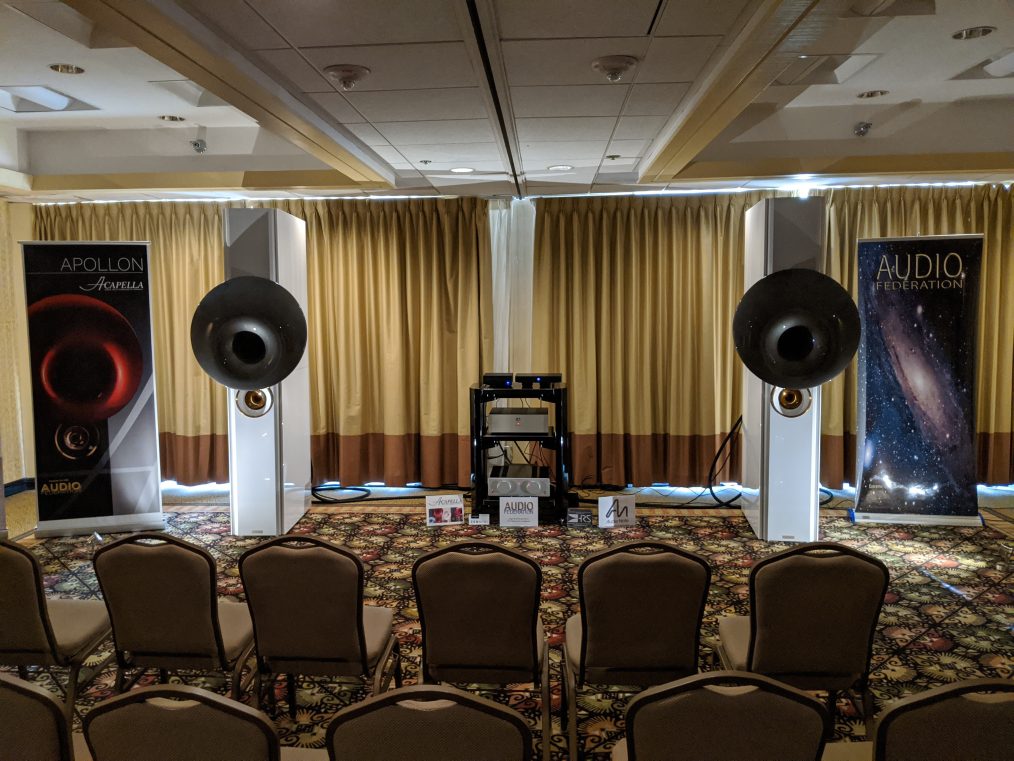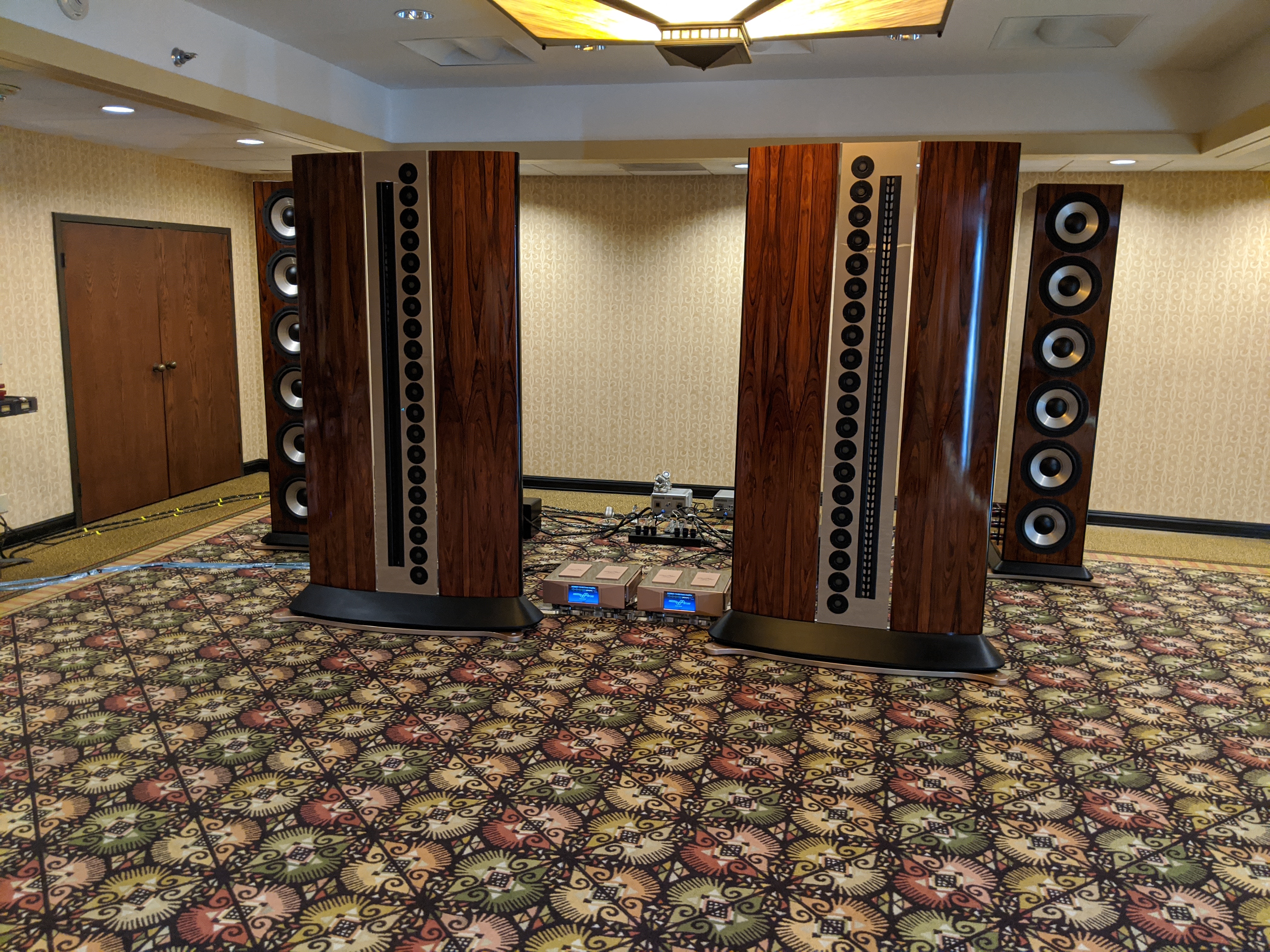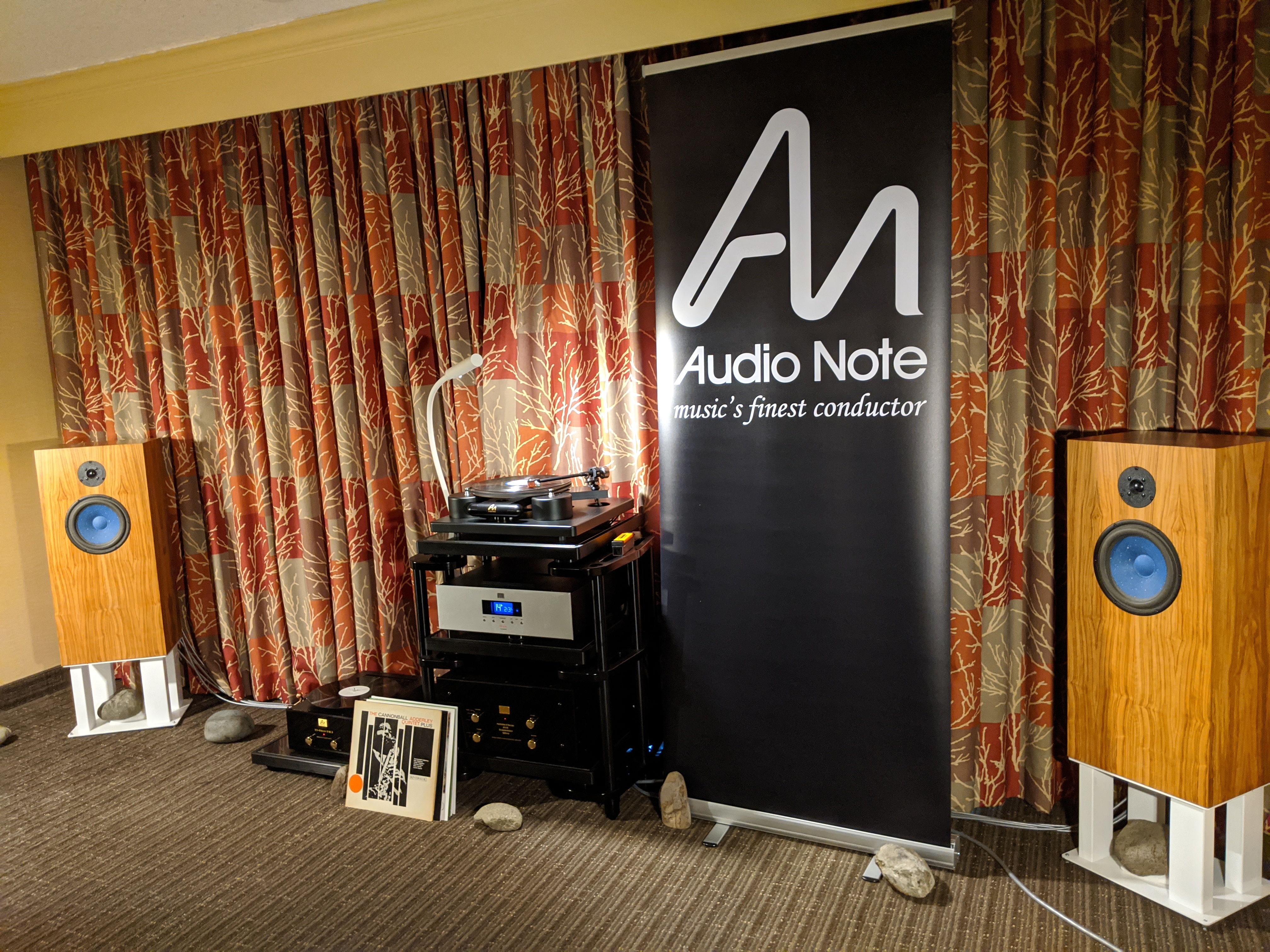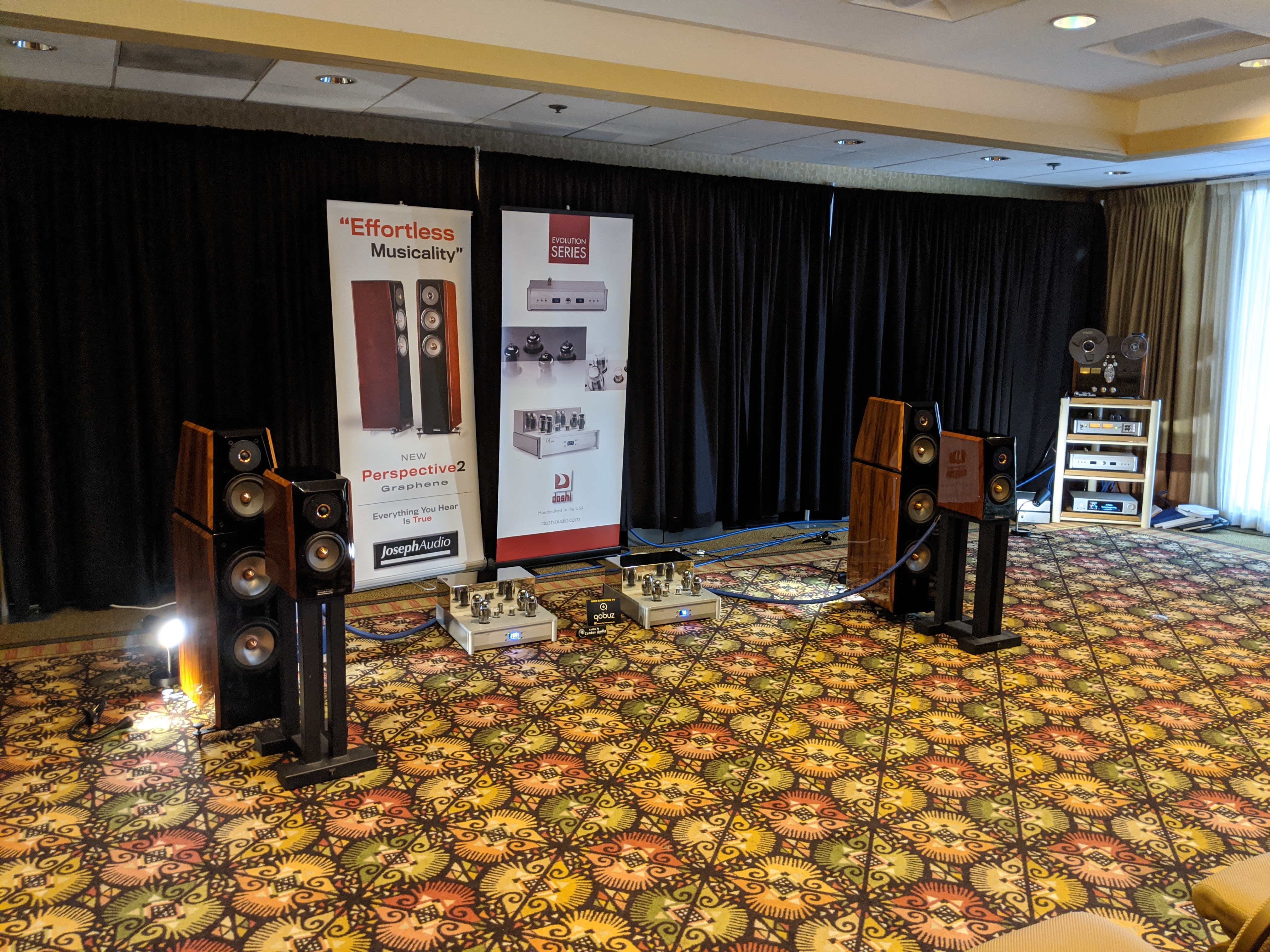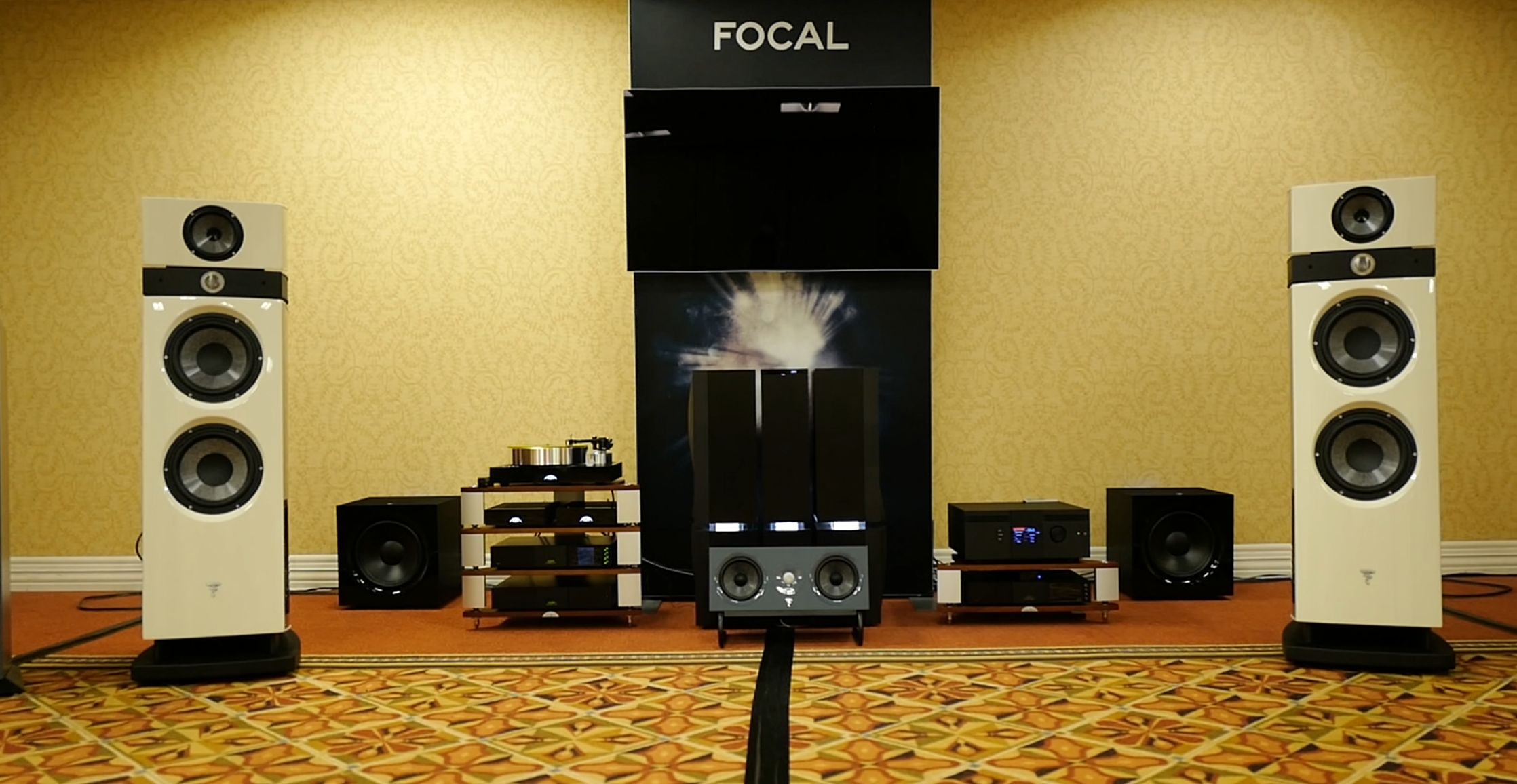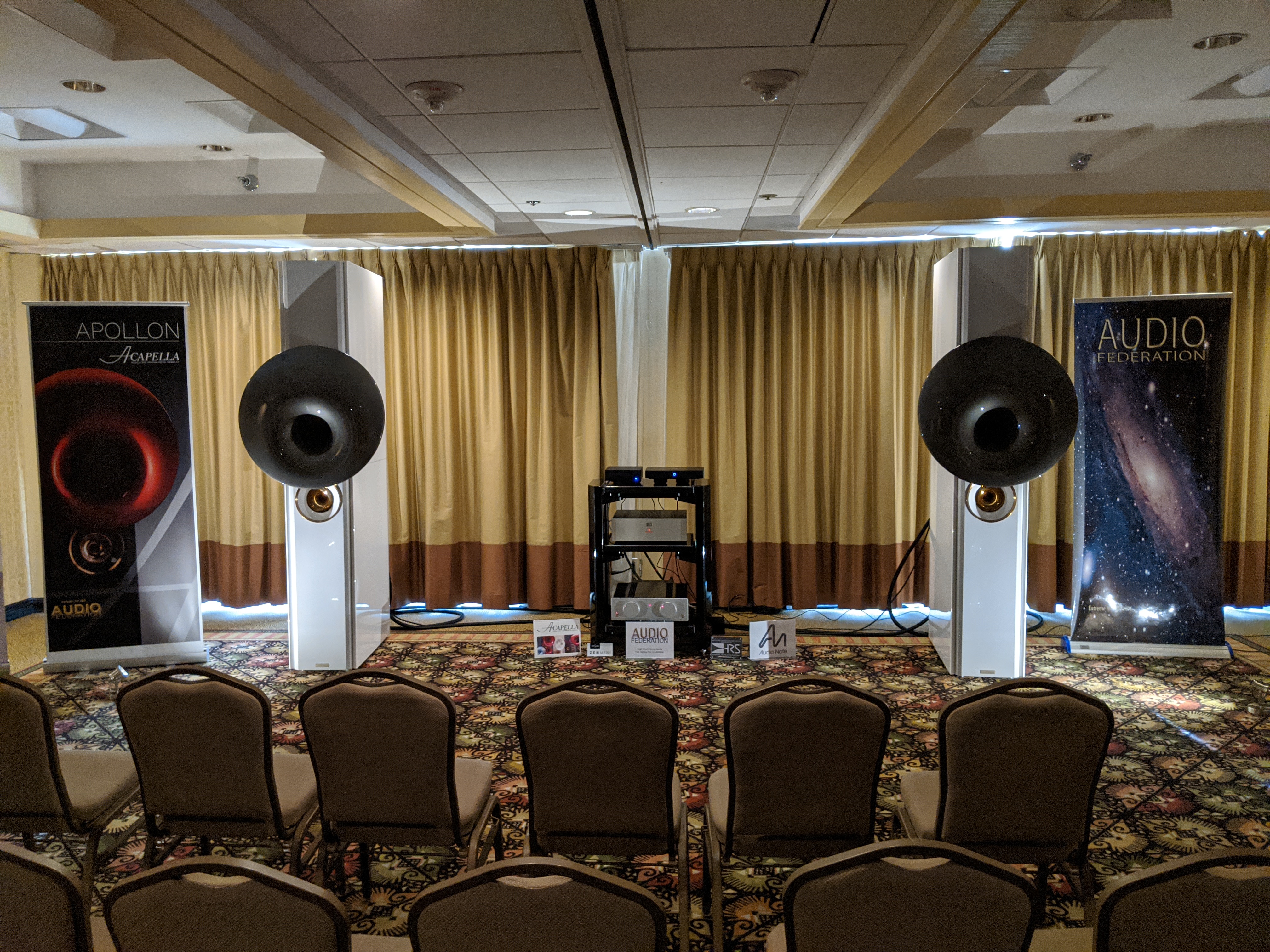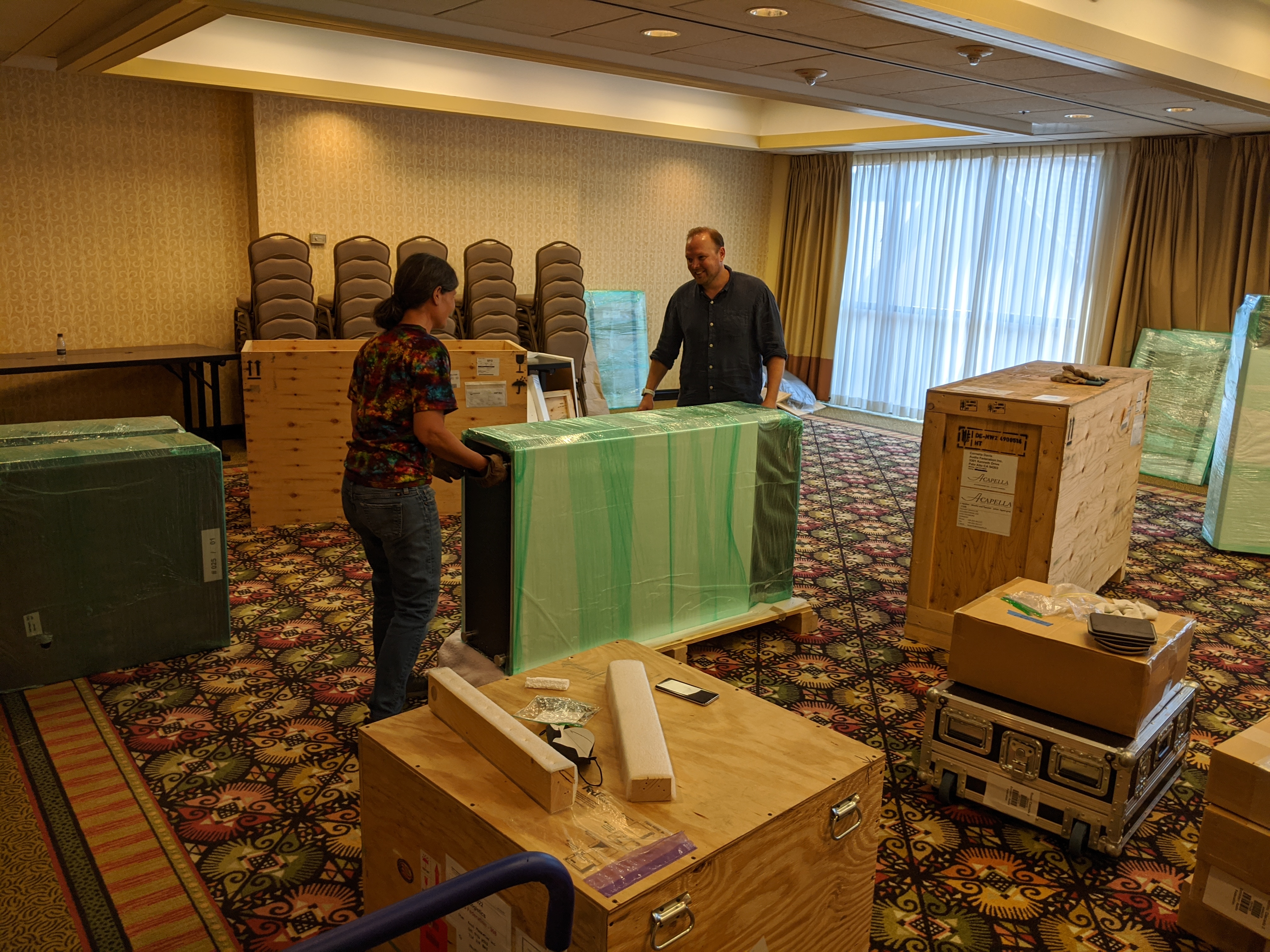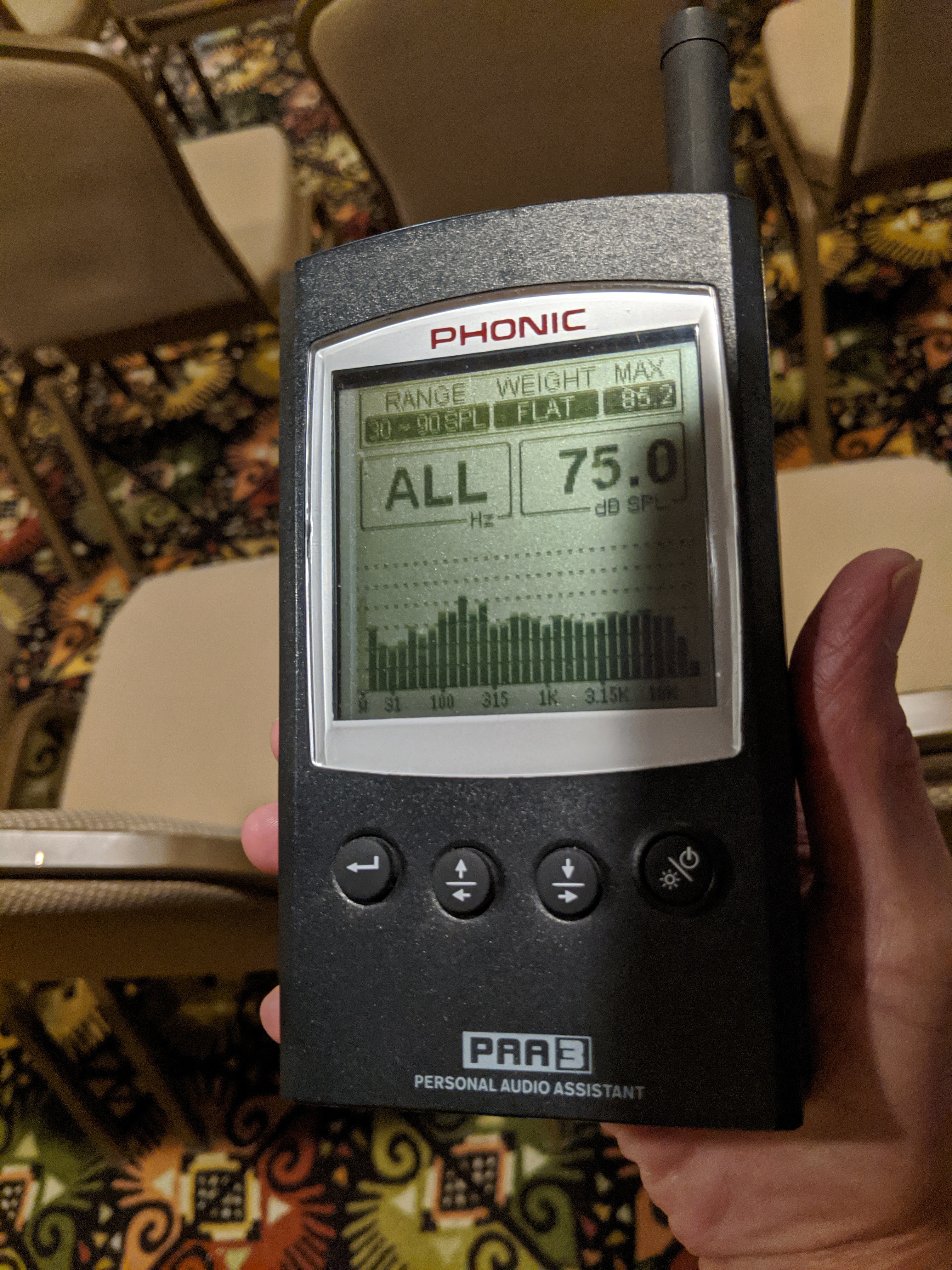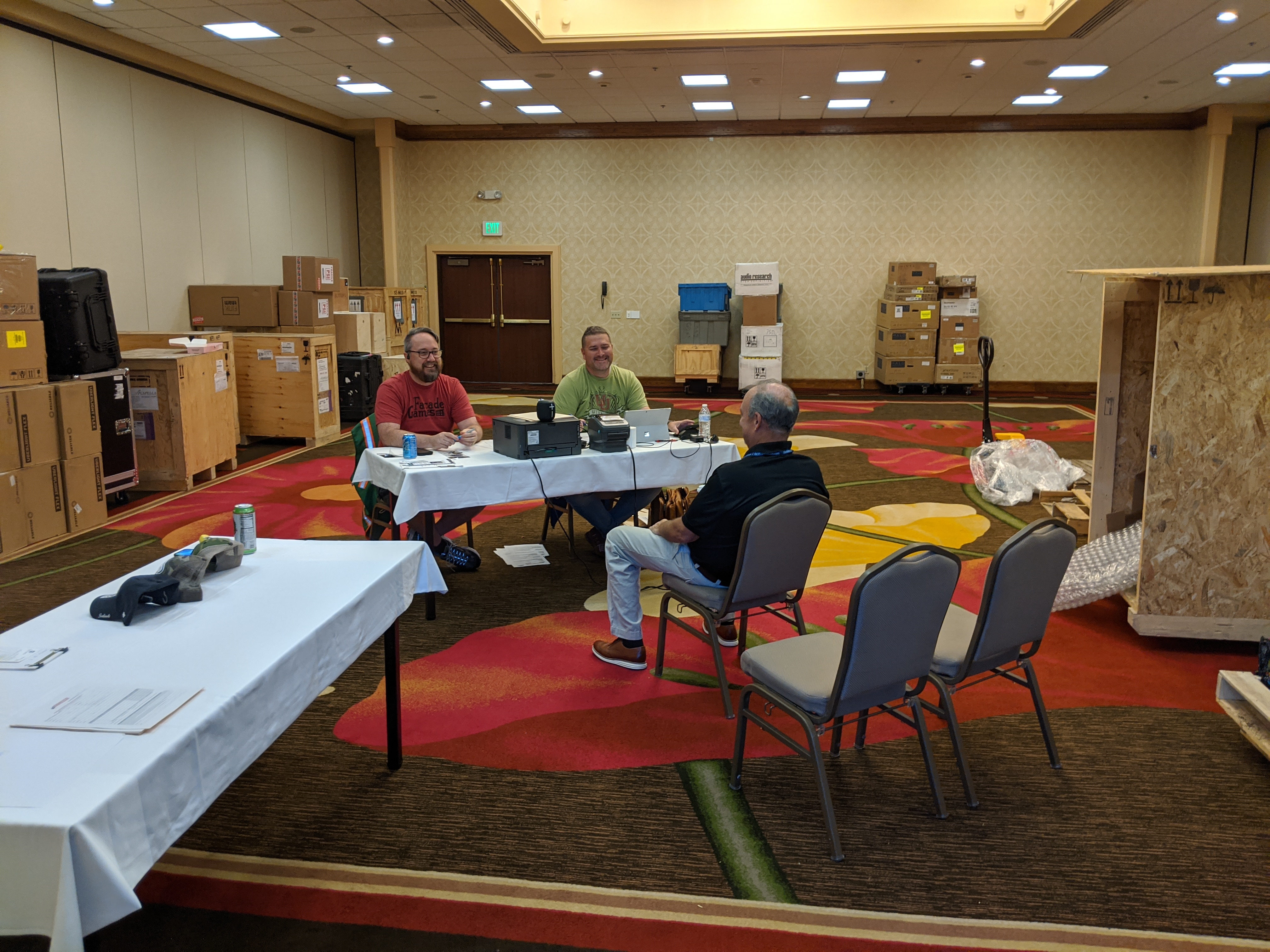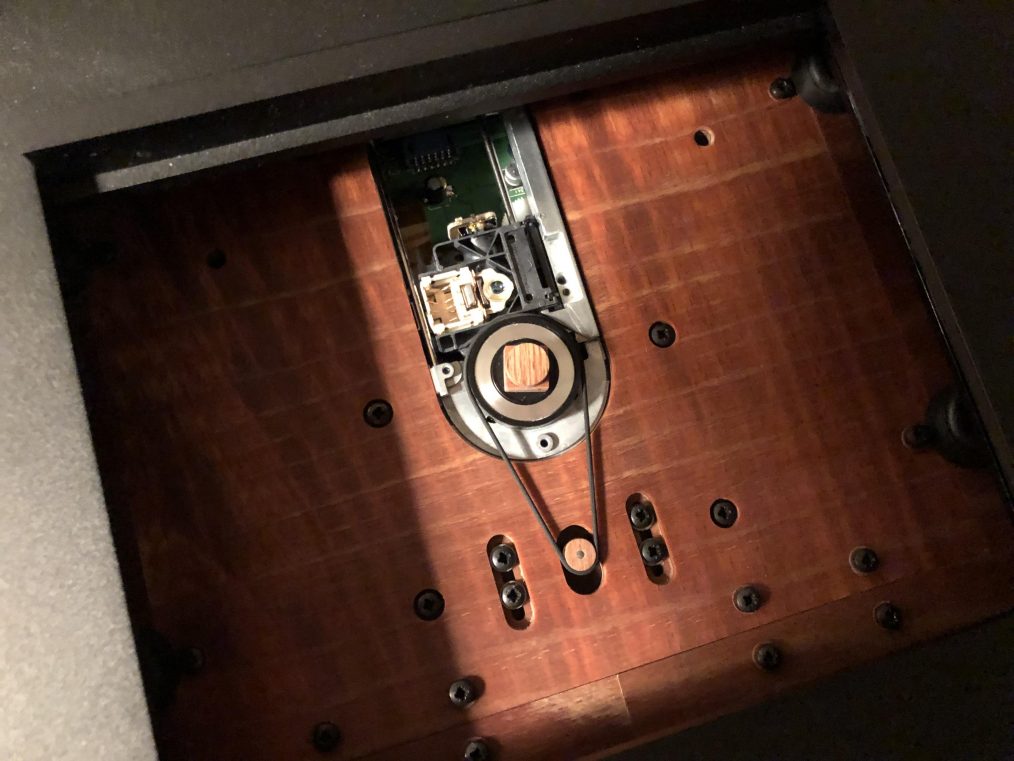Interesting show.
First ever Pacific Audio Fest. First show in Seattle, I think. Home of Microsoft and Amazon. Lots of people who can afford high-end audio.
Show went smoothly – congratulations Lou [Hinkley]! Although there was the usual meet-and-greet and later a special get together with live music, we’ve probably only gone to two of this types of event, ever, after exhibiting at or attending at least 50 shows in the last 20 years. Who has time? We’re either tweaking the system to improve it in this way or that, or we are dinnering with good friends / manufacturers / customers [they kind of blend into each other over time, which is a good thing. As Jeff Wells says, we are just one big (small) audio family]. It was great to see Gary Gill of Capital and Marjorie Baumert of Rocky Mountain using their deep expertise to ensure the show’s success.
Mostly smaller manufacturers at this inaugural show in Seattle, July 29th to 31st. I counted about 50 rooms looking at the room diagrams, and took photos of 49 rooms, as you will see when I post the photos. It was sometimes hard to find all the exhibit rooms, things were spread out, but access was good – the elevators worked and I think everyone got to where they wanted to go in reasonable amounts of time.
Maybe 10% of people wore masks, including Neli and I. No room service since COVID. Seattle food is even more expensive than in the S.F. Bay Area.
Attendance was, unusually, the best on Friday, and Sunday was the slowest, as expected.
The rooms can be divided up into about 4 categories:
- the small rooms in the “wings”, there were 8 hallways that were full of these rooms
- the conference rooms like the one we were in, primarily one long hallway
- the rooms on floor 13, the penthouse, another long hallway
- and a few very large rooms next to or close to the headphone and booths areas
As far as I could tell people were more or less evenly distributed between these areas – though I suspect people self-select themselves to be more interested in one area or another when making repeat visits.
I tried to take at least one photo of each room [see the rest of the posts for this show here on the blog]. I took some video and recordings in 24×96, but truth to tell, videos take me some amount of time to process and merge with the audio, and I just wasn’t in the mood to commit myself to a comprehensive effort while we are still in the process of moving house and store here in the S.F. Bay Area.
I did record [well, tried to record, haven’t listened to or watched any of them yet] the Audio Federation room, the Joseph Audio room, the Genesis room, the Acora room, the large Daedalus room, and the Audio Note UK room, with Vincent Bélanger playing his cello.
Instead of a Best of Show [sorry, we hear what we hear, and our bests would bore many of you as being too obvious], we now present:
The Most Interesting, Weird, Awesome, Different of Show
Genesis – Huge System Award
Two massive wooden panels, two woofer towers. A very large room. Three(!!!) reel-to-reel decks. At least 5 people staffing the room. The sound? Near the end of the last day, I heard one of the tape decks as a source and it was much more interesting and much closer to what I originally expected to hear here during my earlier visits. We all know many people listen with their eyes – and it did look very impressive. It would have required more time listening to make any real judgement – massive panels like this have a different sound than most speakers and are not familiar enough that I can make efficient judgments. All-in-all, with tape, this room was more or less on par with the Estalon, the Alsyvox, the Gobel rooms.
Acora Acoustics – Exceeding Expectations Award
Two small granite speakers in a very large room (50×50?). They were able to get an amazingly large sound and a significant amount of bass from these speakers being driven by a VAC amp [not known for having especially strong bass]. Yes, there were bumps of bass – more of it at some frequencies than others – but it was overall enjoyable to me. And I just like granite speaker cabinets, and for some reason like them better than aluminum cabinets, and like them both better than traditional cabinets. Zero cabinet reverberations – what’s not to like. [yes, yes, there is much more to speakers than just cabinets or lack of resonance, and speakers like Audio Note turn resonance to their advantage]. The sound itself showed weaknesses in the drivers and source – but the weaknesses were fairly balanced and I enjoyed listening here.
Audio Note U.K. – Innovative Speaker Setup Award (or most Innovative Use of Hotel Garden Rocks Award)
At the last minute, discovering that there were not two symmetrical corners into which the AN speakers prefer to be placed, the speakers were placed by Vincent and Adrian at angles against the front wall. After filling the speaker stands with sand and using special “audiophile-grade” stones from the yard surrounding the hotel, they were able to assure that the imaging and soundstage were stable across the width of the room, with good dynamics and room engagement [a benefit bestowed by AN and their speakers when setup properly – and as required to get bass from these little 2-ways – we get down to measured flat 20 hz in our little room in Palo Alto].
Daedalus and VAC – Tallest Amps Award
Someone has to be the first to build amps taller than the speakers – and it looks like it is going to be VAC. Many systems at the show had a clean look to them, including this one.
Joseph Audio – Most Amazingly Speaker Positioning in a Large Room Award
As we struggled in our own room with hardware issues and questioned every aspect of our signal chain and setup, I often visited similar rooms to see how they setup their systems. Most were worse than ours [sorry] but Jeff Joseph had setup his relatively small speakers [in comparison with ours and the others on this floor] so that their sound filled the entire room with apparent ease. All frequencies more or less accounted for given the source and limited number and size of the speaker drivers. There is the concept of a “perfect positioning” where speakers will perform 2X [10X?] better than they would just a 1/2 [1/4?] inch away in a different position. Romy the Cat’s forum talked a lot about this many years ago, and I am lucky enough to have heard it several times now [and we even set up a few ourselves]. So hard to make happen intentionally [and beware, most famous speaker positioning experts are worse at this than you are – or than just putting the speakers equal distant from the walls in an equilateral position from the listening chair. We visit people after these kinds of “experts” setup their system and the results are far more mixed than we would have thought they’d be.]
Focal / Naim – Courage to Play Real Music Award
Kudos to the exhibitor who played the ’64 recording of “Time is on my side” by the Rolling Stones. And kudos to the system which did a really decent job of rendering the music in full detail but in a way that was quite enjoyable. It takes courage to play non-audiophile approved music like this once in a while [i.e. something that is NOT either 4-piece jazz, closely-mic’d female vocals, new-age percussion, or audiophile standards like tin-pan alley etc.]. Just this show, I had someone spend a good amount of our time together telling me that we should only play Patricia Barber [yes, we like her music too, but…] and mostly boring-ass-shit [sorry, but how many people really LOVE that kind of music. I mean, once in a while, sure. It is enjoyable. But all the time? ] that are such simple compositions that they can’t possibly sound bad. [The counter argument is that shows are just for demonstrating the best that a system can perform, not about showing a system’s overall capability. But the room above showed me much more about its relatively high-quality than if they had played Patricia Barber – so for me, at least, I want to hear a wide variety of music on show systems].
At one of our last shows pre-COVID, I had the exhibitor next door come over for a visit to hear our room and spent the time telling me that I was wasting his valuable time because we were playing Massive Attack instead of some audiophile greatest hit that would “show off the system to best effect”. As a way to show off a system’s capabilities, audiophile-approved music is near worthless. It is like a car salesperson who insists on doing the driving and puts around nice new smooth backroads. Better is the car salesperson who lets you take the car home over night. We try to something as close as possible to that by handing you the Roon-powered device so you can play your own music – and, barring that, we try to play a wide variety of music that WE love, hoping it will strike a chord.
Although I think we only agree with about half of the infamous Audio Hell tirade below, it provides food for thought about what music we should be listening to when evaluating a system.
Audio Federation – Forced to Stream at a Show and Loved it Award
Streaming. People started doing this at shows several years ago, but it had sounded so inferior that we’ve always preferred vinyl, CD and better-than-CD music servers. Until now. Yes, we are cheating by using a level five Audio Note DAC that, unlike most, if not all, other DACs, exposes so much information in the digital stream with so much effortless authenticity that the sound is very, one might say, both post-digital and post-analog in comparison – and not the usual high-res technical tour-de-force that most other DACs go for which, although impressive, don’t sound a heckuva lot like music sometimes.
So here we are…
Every album and every track.
On tap.
In high fidelity.
What a world.
This was also the debut of Acapella Audio Arts “Apollon” loudspeakers at a U.S. show. It was daunting for Neli and I to take on setting up these 700lb speakers. [with Rusty and Royal’s help for the top cabinet and Adrian + Vincent from Audio Note helping with setup and tear down. Thank you all so much!].
Our Story (aka with a little help from our friends)
As exhibitors, we had the most difficult and trying show setup we have experienced in over 15 years of exhibiting at many, many shows – along with (on the last day!) probably the best sound we have ever had at a show. We have been incredibly lucky over the last years; previously everyone and everything just turned up and worked as expected. Not this time.
[Mike taking photos while Adrian and Neli ponder moving the 450lb Acapella Apollon base unit. Thank you Adrian!]
Lufthansa strike
A last minute Lufthansa strike meant that the Acapella team (Hermann and Lucy) were unable to fly from Germany on time, adding a layover in Anchorage Alaska and not arriving in Seattle until early Friday morning after an incredibly long airplane trip. They normally bring a router to use with the Acapella music server at these shows, so we hadn’t brought one. So, quick trip to Best Buy and we got a new Amplifi “Alien” router, as was recommended to us as good for security here for the long term [thanks, Ray!]. Neli used her sys-admin skills to set that up – didn’t take too long [ and not too many F-bombs 🙂 ] before we had our Music Server talking to the Internet and the user interface for it working on our phones.
Music Server problems
But then the Music Server just wouldn’t send out a digital signal. That meant we couldn’t use the $120K Audio Note DAC5 Signature [with awesome new to us NOS tubes which, to my ears, added a increased sense of reality and solidity and texture to the frequencies around 1000hz. So voices, lead guitar, etc. all were amazingly rich and solid and addictively detailed both harmonically and dynamically]. We played the DAC and analog outputs built into the $8K Acapella Audio One music server instead. As well as this worked (the Audio One on its own well outperforms its price), it just isn’t the sound we are going for and want to present at shows. We played it occasionally but it normally serves as our exclusive digital source, filled with playlists and recordings that we (and Acapella) love. We are not yet sure whether the cause of this digital output issue is corruption of the indexing data on the hard drive or something else.
With a little help from our (new) friends
So, Neli went foraging for a source somebody might not be using, up and down the halls of the Pacific Audio Fest hotel. I think she talked to Linear Tube Audio, and I know she talked to Hawthorne Stereo, a local dealership, and we thank everybody for their efforts on our behalf. In the end, the folks next door (Parasound, showing with Olson Hi-Fi) connected us with Kevin Jackson from Innuos, who came through by remembering that Jeff Wells, co-founder of Wells Audio, had mentioned he had an entry-level Innuos streamer at the show that he wasn’t using. So, due to Kevin’s hard work and Jeff’s generosity [Thanks, Jeff!], we hooked up a $1400 Innuos ZenMini to the Audio Note U.K. DAC5 Signature. Yep, the little ZenMini was the source for our $400k+ system.
We’d heard good things for years about Innuos, from Mark at Well Pleased Audio Vida, and from David Cope (Old Forge Audio). And some of our customers have Innuos. So we thought it might be good. It worked great! The better ones will work even better, we think (stay tuned).
Our goal for our room sound
Using Roon for the user interface, freshly downloaded to our phones, and Qobuz to supply content, we had a blast making a demo playlist at the last minute [OK, a little stressful also. YOU try remembering enough tracks, tracks that really kick ass and at the same time are familiar to the average audiophile and at the same time represent many genres and at the same time represent various levels of recording quality and complexity to demonstrate how the system truly handles the real world playback requirements of the most sophisticated audiophile with aplomb – enough to fill several hours of playback time every day – as quickly as you can. The fun parts and stressful parts will become immediately obvious to you]. Neli thought that maybe her Roon playlists would be stored in the cloud but no; they only exist on our local Roon core, which was left at home for this show.
Finally getting to focus on the details
We still weren’t getting the sound we wanted… but why? One of the major advantages experienced audiophiles have is that we know how things are supposed to sound. especially if we are very familiar with the actual gear being used.
But this was our first show where we used digital streaming as the source in public… We use an EMM Labs NS1 steamer at home, and it has been a joy to use – but streaming at a show?
The Innuos ZenMini on the left, the Acapella Audio One music server on the right, above the ANUK DAC 5 Signature and Acapella integrated amplifier.
First we put the ZenMini on the HRS platform using Nimbus isolators like any other first class component. That helped. Then Hermann discovered that Roon had device volume control turned on. Oops. So, turning THAT off helped. The speakers still weren’t engaging the 30 feet x 29 feet room like we wanted, and we played some pink noise and measured a suckout at 45hz. We thought a lot about adjusting the speakers to try and reinforce those frequencies – but 700lb speakers are not so easy to move around, and we had already moved them to optimize for the attendee’s tendency to sit anywhere they want, from well outside the speakers to the sweet spot, and it worked great with a decent image and soundstage available to all those seated and standing).
Finally, we played with the grounding technology of the DAC5 [there is a switch. What can I say], and whereas it always generates higher gain sometimes it exposes things in the input signal that cause a degradation in sound quality – but in this configuration, with this system, on this day, it was 100% freaking awesome. Luckily Hermann and Neli insisted on us all trying it again Saturday, after show closing – and Wow. Still a suckout at 45hz, but the profile was improved and the additional gain engaged the room much better. Not perfect, not like it should be, given more time to spend on setup [Jeff Joseph a few doors down in a similar room had one of the most perfectly positioned speakers I have ever heard – so it is possible to significantly improve the setup in these rooms. Hopefully we can apply the same technique he used, but with our hybrid horn speakers, next year].
Rusty and Royal, freight magicians and top Acapella speaker cabinet putter-uppers (and taker-downers). Their RG Logistics now provides white glove setup services.
But in the end our sound was at a point which was better than anything we have personally heard at a show in terms of the sonic attributes that we personally treasure [sonic attributes we think are necessary for an audiophile who wants to play many genres of music, as well as music of various recording qualities, and have the sound, as much as possible, do everything very, very well, while at the same time doing nothing badly. Our current addiction is for as much true-to-life dynamics at all levels of SPL and frequencies and for the entire spectrum of micro-, midi- and macro-notes…. plus as much harmonic integrity and true-to-life nuance real instruments generate as possible. We hope people got a sense of the potential of this approach at the show].
Finally
So, very high fidelity with a streaming source.
Neli is all “It was supposed to be like this THE FIRST DAY!!! This is what it is supposed to sound like!” but I am happy that we got to this point at least at some point during the actual show. And in comparison to the other sounds at the show, we always were complete sounding, without any frequencies over emphasized or screechy, always engaging and musical – just not so much of the punchy dynamics and big open sound we had on the last day. The people who came by the last day got to hear something that we were proud to present as an Audio Federation room [our co-sponsored Audio Note U.K. room, setup by Vincent and Adrian, was perfect on day one, so at least that went as planned].
All packed up and ready to ship. See ya all next year!

